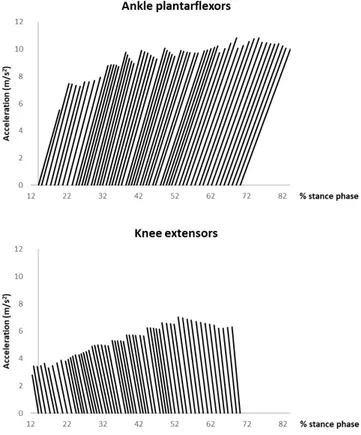http://www.diva-portal.org
Postprint
This is the accepted version of a paper presented at International Society of Biomechanics,
Calgary, Kanada, 31 July - 4 August 2019..
Citation for the original published paper:
Azcarate, L., Sandamas, P., Arndt, A., Gutierrez-Farewik, E M., Wang, R. (2019)
Muscle contributions to body mass centre acceleration during the first stance of sprint
running
In:
N.B. When citing this work, cite the original published paper.
Permanent link to this version:
Muscle contributions to body mass centre acceleration during the first stance of sprint running Laura Martín de Azcárate1, Paul Sandamas2, Anton Arndt2,3, Elena M. Gutierrez-Farewik1,3, Ruoli Wang1
1 KTH Mechanics, Royal Institute of Technology, Stockholm, Sweden 2GIH, Swedish School of Sport and Health Sciences, Stockholm, Sweden
3Karolinska Institutet, Stockholm, Sweden
Email: lauramda@kth.se Summary
The aim of this study was to determine how individual lower-limb muscles contributed to body COM acceleration during the first stance of sprint running when the runner presented a considerable side-to-side movement at the beginning of a sprint start. It remains unclear whether a wide step width affects muscle contribution and if so, what its influence is. Introduction
The best results in sprint running are based upon developing the greatest forward acceleration, reaching the maximal speed, and keeping that speed over the remainder of the run [1]. The greatest forward acceleration is generated in the first stance of a sprint due to the very high propulsive force production [2]. A wide step width is associated with high force generation during long foot-ground contacts [3]. Thus, the first step of wide-base-width sprinters was selected to study body COM accelerations induced by major lower-limb muscles. Methods
Four (2 men and 2 women) internationally-competitive sprinters (mean ± SD: height 1.75 ± 0.1 m, mass 70.25 ± 14.04 kg, personal best for 100 m: men 11.23 ± 0.35 s, women 11.62 ± 0.45 s) performed several sprint start trials with their natural wide step width (0.33 ± 0.03 m) in a motion capture lab. Marker trajectories were sampled at 250 Hz and GRFs were recorded at 1500 Hz. Data were low-pass filtered at 50 Hz with a 3rd order Butterworth filter. EMG patterns were
measured at 1500 Hz using surface electrodes on six muscles. A 12-segment, 29-DOF musculoskeletal model [4] was used in OpenSim v3.3 and scaled to each participant’s anthropometry. Joint angles were generated with inverse kinematics. Joint moments were computed with the residual reduction algorithm, which also adjusted the model to resolve dynamic inconsistencies. Muscle activations were calculated with computed muscle control and constraints were used to match better EMG. Finally, an induced acceleration analysis was performed and individual muscle contributions to fore-aft, vertical, and mediolateral COM accelerations were estimated. Results and Discussion
Ankle plantarflexors were the largest contributors to induced support and propulsive body COM acceleration for the fastest female sprinter (Figure 1). The knee extensors (rectus femoris, vastus medialis, vastus lateralis, and vastus intermedius) also contributed to upward acceleration but decelerated the body COM in the direction of progression. Hamstrings, tibialis anterior and adductors contributed to downward acceleration.
Figure 1: Ankle plantarflexors’ (top) and knee extensors’ (bottom) contributions to fore-aft and vertical body COM accelerations.
The vasti were the largest contributors to medial acceleration, followed by rectus femoris, gastrocnemius, and soleus. This direction has not been studied before during a sprint start to the best of our knowledge.
Conclusions
Ankle plantarflexors were the main contributors to body propulsion and support, while knee extensors decelerated forward propulsion but induced medial accelerations. Hip extensors and hip adductors did not offer a remarkable contribution to body COM acceleration in any direction. Better understanding of muscles’ induced COM accelerations may provide some explanation for sprinters’ very wide first few steps.
References
[1] Ross A et al. (2001). Sports Med, 31: 409-425.
[2] Salo AIT et al. (2008). Proceedings of XXIII ISBS; Q. Wang.
[3] Ito A et al. (2006). IAAF NSA, 21:35-39.
